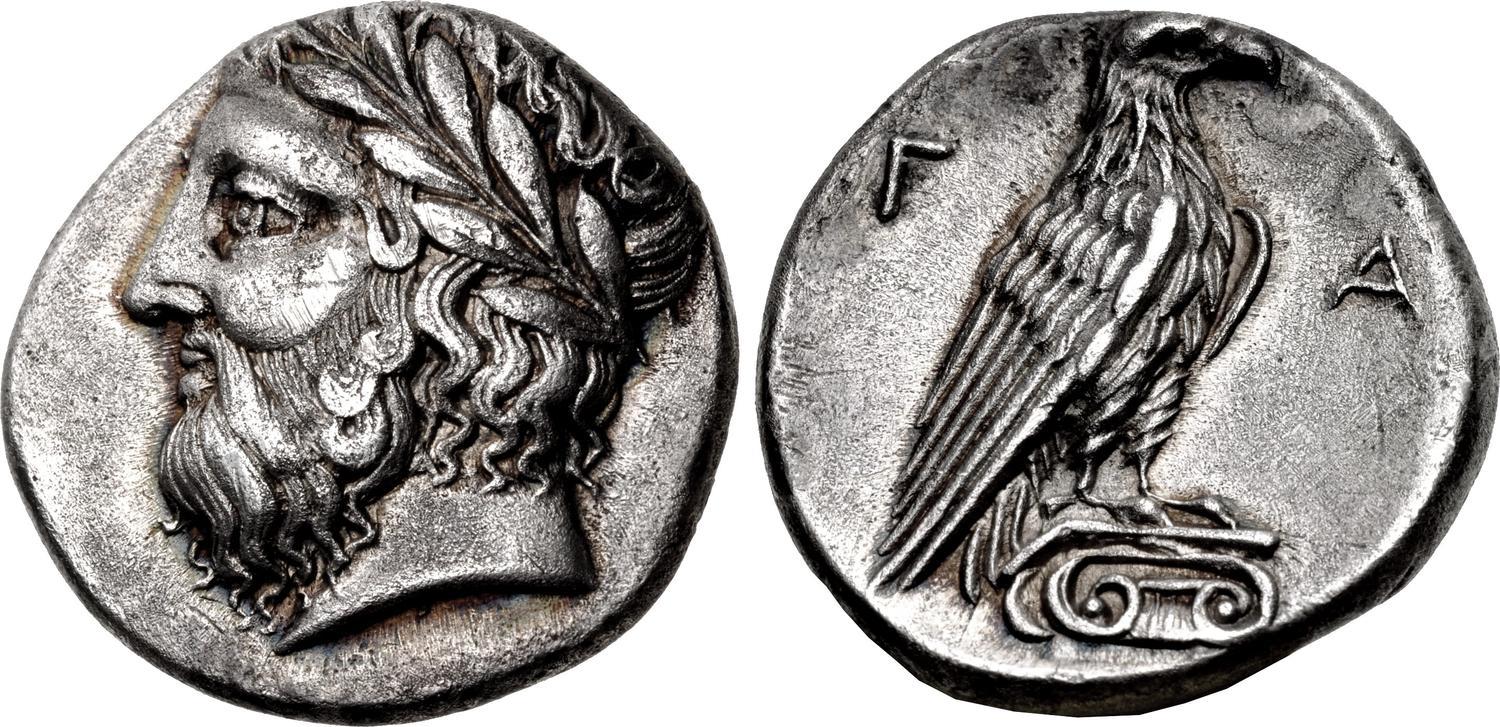Elis, silver, staters (various types related to Zeus) (363-271 BCE)
From SILVER
363 BCE - 271 BCE Silver 10,362 kg
Description
| ObverseInscription or printing placed on the obverse.: | Head of Zeus left, wearing laurel wreath. |
| ReverseInscription or printing placed on the reverse.: | FA (Greek).Eagle, with closed wings, standing right on Ionic capital, F-A flanking. |
Mint and issuing power
| MintIdentifies the place of manufacture or issue of a numismatic object.: | Elis | Ancient regionAncient region.: | Peloponnesus | Modern countryModern country: Greece | AuthorityIdentifies the issuing power. The authority can be "pretended" when the name or the portrait of X is on the coin but he/she was not the issuing power. It can also be "uncertain" when there is no mention of X on the coin but he/she was the issuing power according to the historical sources: |
Chronology
| FromIdentifies the initial date in a range assigned in a numismatic context. | 363 BCE | toIdentifies the final date in a range assigned in a numismatic context.. | 271 BCE | PeriodTime period of the numismatic object.: Classical 480-323 BC |
Physical description
| MetalThe physical material (usually metal) from which an object is made.: | Silver |
Median weightMedian of the weights of numismatic objects (in grams). in grams | 12.30 | DenominationTerm indicating the value of a numismatic object. Examples: tetradrachm, chalkous, denarius.: | stater |
StandardStandard.: |
Image

AC206 Olympia.jpeg [1]
References
| Die study referencePublication of the study: | Seltman 19211Seltman 1921, series XX-XXV, n° 175-241. | ||
| Coin series referenceReference to coin series study: | HGC 52HGC 5, n° 365, RQEMAC3RQEMAC, n° 206 | ||
Obverse dies distribution
| FrequencyFrequency of specimen in distribution. ᵖ | Number of obversesNumber of obverse dies. ᵖ (o) | % (o) | Number of coinsNumber of coins. (n) | % (n) | Die nameName(s) of the die(s). |
| 1 | 13 | 37.14 | 13 | 10.48 | CF, CG, CH, CJ, CL, CO, CP, CU, CY, CZ, DF, DG, DJ |
| 2 | 6 | 17.14 | 12 | 9.68 | CB, CN, CV, DB, DH, DK |
| 3 | 4 | 11.43 | 12 | 9.68 | CQ, CS, DA, DE |
| 4 | 3 | 8.57 | 12 | 9.68 | CK, CM, DC |
| 5 | 2 | 5.71 | 10 | 8.06 | CC, CR |
| 7 | 1 | 2.86 | 7 | 5.65 | DD |
| 8 | 1 | 2.86 | 8 | 6.45 | CW |
| 9 | 2 | 5.71 | 18 | 14.52 | CT, CX |
| 10 | 1 | 2.86 | 10 | 8.06 | CE |
| 11 | 2 | 5.71 | 22 | 17.74 | CA, CD |
| Total | 35 of 35 | 99.99 | 124 of 124 | 100 |
Reverse dies distribution
no distribution is available
Quantification
| Number of obversesNumber of obverse dies. ᵖ (o) | 35 | Number of singletons (o1)The number of singleton coins. ᵖ | 13 |
| Number of reverse diesNumber of reverse dies. (r) | 61 | Number of coinsNumber of coins. (n) | 124 |
| Coins per obverse dieNumber of coins per obverse die. (n/o) | 3.54 | Coins per reverse dieNumber of coins per reverse die. (n/r) | 2.03 |
| Reverse per obverse ratioRatio of obverse dies divided by reverse dies. (r/o) | 1.74 | Percentage of singletons (o1)number of coins (n) divided by the number of singletons (o1) ᵖ | 37.14 % |
| Original number of dies (O) (Carter 1983 formula)The estimation of the number of coins according to Carter 1983 ᵖ | 42.12 | Coins struck if 20,000 as average productivity per dieCoins made if the average productivity for obverses (according to Carter) is 20,000. ᵖ | 842,400 |
| Original number of dies (O) (Esty 2011 formula)The estimation of the number of coins according to the singleton formula in Esty 2011 ᵖ (O) | 48.76 | Survival rate if 20,000 as average productivity per dieSurvival rate if average productivity is 20,000. ᵖ | 0.00015 |
| Coverage (o = % of O) (Esty 1984 formula)Esty 1984 - coverage (% of O) ᵖ (o = % of O) | 89.52% | Die productivity if survival rate 1/2,000Average productivity if survival rate is 1/2,000. ᵖ | 5,887.94 |
| Weight of silver (in kg) if 20,000 coins per die (O = Carter formula)Carter 1983 * Median weight * 20000 (*10 if gold or electrum) ᵖ | 10,362 kg <br /> 10,362 kg | Die productivity if survival rate 1/5,000Average productivity if survival rate is 1/5,000. ᵖ | 14,719.85 |
Remarks
References
- ^ Seltman, Charles T. (1921), The temple coins of Olympia, Cambridge, ix, [1], 117 p. : 1 ill. ; 25 x 19 cm. and XII pl.
- ^ Hoover, Oliver D. (2011), Handbook of Greek Coins 5. Coins of the Peloponnesos, Achaia, Phleiasia, Sikyonia, Elis, Triphylia, Messenia, Lakonia, Argolis, and Arkadia, Sixth to First Centuries BC, Lancaster (PA), 2011.
- ^ Callataÿ, François de (2003), Recueil quantitatif des émissions monétaires archaïques et classiques, Numismatique Romaine, Wetteren, VII + 267 p.